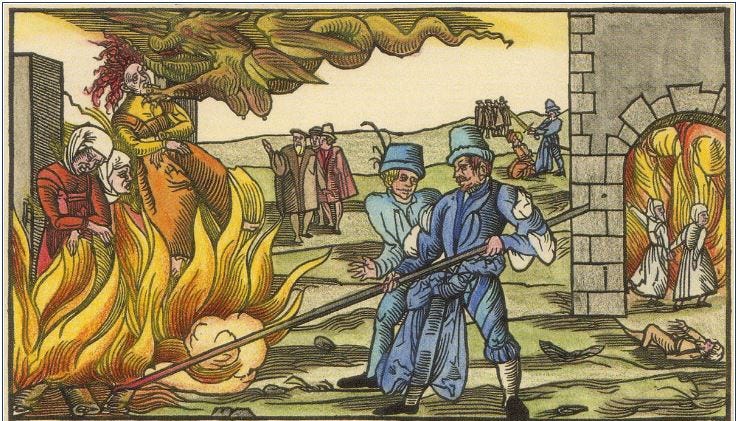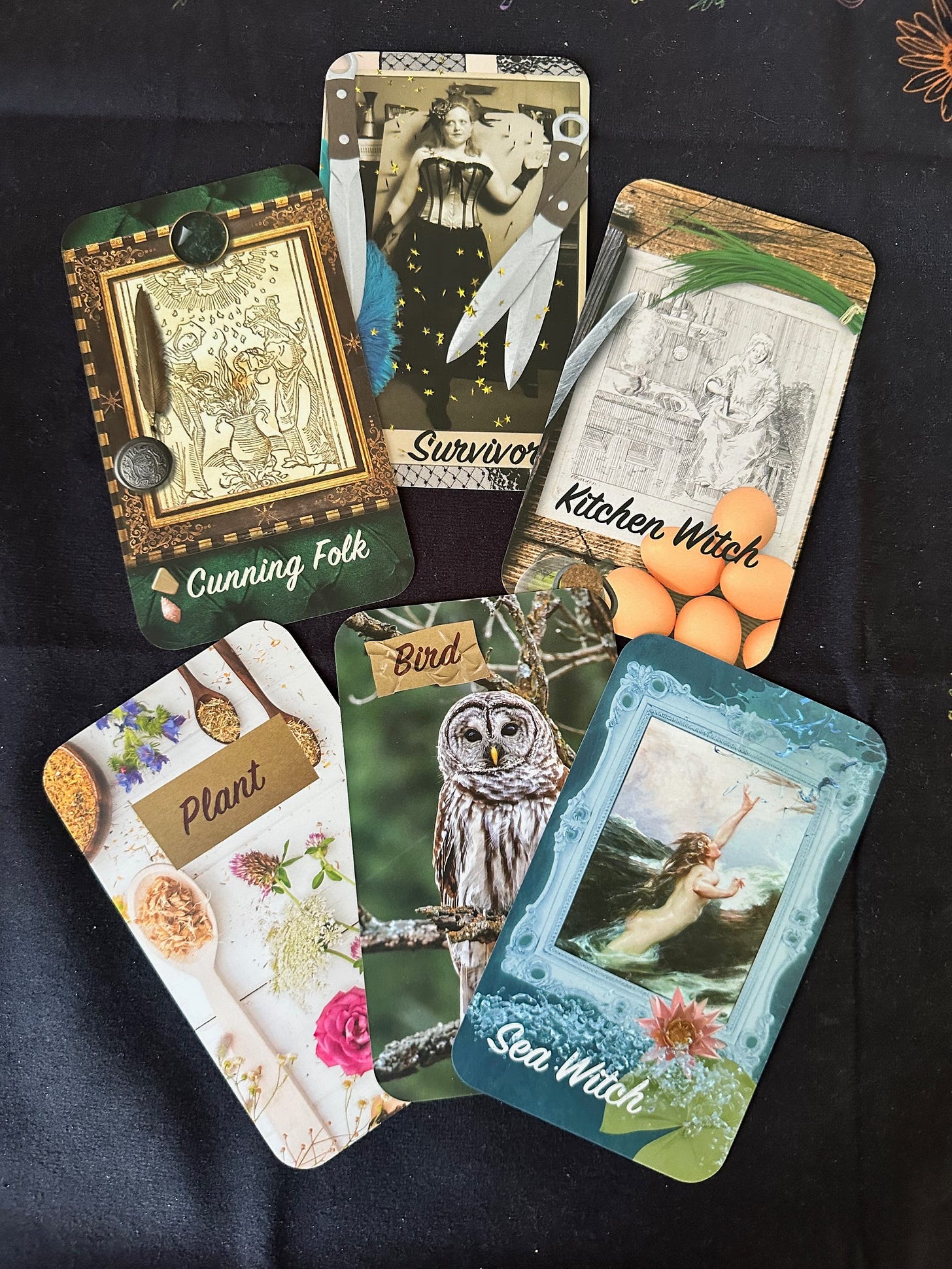This is a long one. Be sure to read all the way to the end!
Have you ever noticed how society,
at least in the U.S., has a problem with powerful women? In fact, throughout history, there’s been an odd tapestry woven with threads of fear, a few of admiration, and more of outright hostility.
Legends of enchantresses, witches, and goddesses - all embodying immense power - have given birth to myth and story. After all, a woman is reported to turn men to stone with a glance, while mermaids sang sailors onto the rocks to drown them.
I think when women exhibit strength, intelligence, or assertiveness beyond prescribed norms, cultural anxieties emerge. This has manifested in various forms throughout history, most notably in the form of accusations of witchcraft against healers and wise women. We Americans point to Salem, Massachusetts, as the high point of mass hysteria, but in reality we were just a blip when compared to Europe.
[Image: The North Berwick Witches meet the Devil in the local kirkyard]
Looking at Scotland, home of
the three witches in Shakespeare’s Macbeth who, instead of making Macbeth the King of Scotland, lead him to his demise. Fifty years before Will penned Macbeth, King Henry VIII passed the first English Witchcraft Act, which officially made the practice of witchcraft punishable by death. In fact one of the charges against wife #2 (Anne Boleyn) was that of practicing witchcraft.
Once Elizabeth I was on the throne, a new Act imposed death on anyone using witchcraft to harm another person. Is it possible that a Queen as powerful as Elizabeth might have threatened the status quo of the men around her? Hmmm.
[Image: Darnley Portrait of Elizabeth I of England.
Up north, a series of persecutions and executions took place between the late 16th and early 18th centuries. During this period, Scotland, like many parts of Europe, was entrenched in religious turmoil, with tensions between Protestantism and Catholicism. The Reformation and the subsequent establishment of the Protestant Church brought about significant changes in religious practices and beliefs, creating an atmosphere ripe for suspicions of heresy and the supernatural.
One of the earliest and most notable Scottish witch trials occurred in 1590, known as the North Berwick Witch Trials. This case involved accusations of witchcraft against a group of individuals (including prominent figures like Agnes Sampson) who were accused of conspiring to bring harm to King James VI of Scotland through supernatural means. This trial gained notoriety due to its connection to the royal family and resulted in confessions obtained through controversial and brutal interrogation methods.
Usually women (though men were also targeted) were accused of consorting with the devil, casting curses, causing illnesses, or engaging in rituals that threatened the well-being of their communities. The accused had little chance of a fair trial, as confessions were frequently extracted through torture or coercion. The use of torture methods, such as sleep deprivation, pricking with needles, or the infamous "witch's bridle" (an instrument used to silence the accused), often led to confessions that were then used as evidence against them.
Records indicate that hundreds of individuals were accused, tried, and executed during the Scottish witch trials. The exact number of victims remains uncertain due to incomplete records and varying estimates across different regions.
The culmination of the Scottish witch trials came with the Witchcraft Act of 1735, which marked a shift in attitudes toward witchcraft accusations and trials. The Act repealed the previous laws that criminalized witchcraft and made accusations of practicing witchcraft punishable by law, emphasizing the need for tangible evidence rather than mere accusations or confessions.
But Scotland wasn’t the only
place where healers, wise women, and midwives were put on trial for witchcraft. The German witch trials spanned several centuries, from the late 15th to the early 18th. Germany experienced a wave of witch hunts that led to the trial, torture, and execution of thousands of alleged witches.
The publication of the Malleus Maleficarum (The Hammer of Witches) in 1487 by Heinrich Kramer and Jacob Sprenger, two German Catholic inquisitors, further fueled the hysteria surrounding witchcraft. This influential book served as a manual for identifying, prosecuting, and executing witches, providing a framework for the persecution that followed.
[Image: Burning German witches, 1555]
Some of the most infamous episodes of the German witch trials occurred in the city of Trier between 1581 and 1593. Under the leadership of witch hunter Peter Binsfeld, hundreds of individuals—mostly women—were accused and executed, with methods of torture employed to extract confessions.
The trials were not confined to one region; they swept across various German territories, resulting in mass hysteria and a pervasive climate of fear. Entire communities lived in constant apprehension, with the slightest suspicion leading to accusations that could prove fatal.
Estimates of the number of executions during the German witch trials vary widely, but conservative estimates suggest tens of thousands of people—mostly women—were executed. The toll on communities was devastating, with families torn apart and neighbors turning against each other in fear.
The fervor of the witch hunts began to wane by the late 17th century. Changes in legal systems, skepticism toward witchcraft accusations, and a gradual shift in societal attitudes contributed to the decline. The Enlightenment period also played a role in challenging superstitions and promoting rational thinking, leading to a more critical examination of the evidence presented in witch trials.
[Image: 1533 account of the execution of a witch charged with burning the German town of Schiltach in 1531]
As beyond horrible as all of this was, if you think witch trials are a thing of the past, read this article by National Geographic. I swear it will give you the shivers.
But why are witchcraft numbers
soaring today? A recent Pew Research Center survey finds there are 1.5 million Wicca or Pagans in U.S. I suspect that number is low, based on the number of solitary or underground witches.
An article in Quartz stated: Spirituality is now firmly placed in mainstream culture. The growing interest in astrology driven by millennials, as well as the popularity of crystals and tarot cards via the ballooning wellness industry, have brought mysticism from the fringes, and right into your Instagram feed.
Women - particularly young women - are trying to understand themselves within the context of their world. Right now (IMHO), there’s so little we all control, the idea of joining a coven or getting together with girlfriends is one of the many pathways to empowerment. So is reading books like The House Witch, Witchcraft Therapy, and Psychic Witch.
And not to sound like a salesy salesperson, but so is using my own Ancestral Magick Divination Kit expansion packs - particularly the cards associated with various types of witches, like this Green Witch. Of all of ‘my witches’, she is most aligned with the European wise woman - the one who practiced plant magick, healing lore, and nature-based divination.
or this Sea Witch who works with the element of Water, as well as the beings who dwell within the ocean depths. She invites you to pick up shells or sea glass, then imbue them with your own brand of magick, place them on your altar, or use them as talismans.
Reading back over this article, I think
I have the feels about it because powerful/wise women have been ill-treated, disrespected, and undervalued throughout time.
What to do? Get out your cards and your candles and your spell books and your herbal remedies and your folk magick, and begin making our world smarter, more compassionate, stronger, more visionary, and whole.
Who is going to do the healing? We are.
xo
Nancy
Ha! I thought I was done writing this, but something made me want to do a Past Life reading. I have several that I use, but this time used a spread from Emerald Lotus. After doing the spread using my own Ancestral Magick decks (including the expansion packs), I realized why this was such a touchy subject for me.
Here are the positions:
1. Past Life that is heavily influencing my life now. Cunning Folk
2. Why this past life is important. The Survivor
3. How I can heal something from that lifetime. Kitchen Witch
4. A way that I can learn more about this past life. Plant Magick
5. How I can incorporate previous lessons to my current life. Bird Magick
6. Why my soul is pulling me to learn more about past lives. Sea Witch
I’m not going to get into all the ways this fits my life today, other than to say that this past life was about me being a magickal person who probably had to hide her skills. I became the Survivor - something I know how to do in this life. If you’ve followed any of my posts about health and food, you’ll know why the Kitchen Witch is so appropriate!
Okay, this time I think I really am finished writing :)
nh
QUESTION: Do you identify as a witch, either in this life or another? Leave a comment and let’s talk about it.












As a Black woman, I think I am a member of a group perpetually perceived as at the very least, witch-adjacent: powerful, mysterious, creative, in the best iteration: dangerous, angry, unknowable, and other in the worst iteration. I’m fine with that, either way.
Although I don't identify as a witch, as an intersectional woman who is assertive, thinks critically and speaks up about systems change and anti-oppressive leadership--all of which breaks me from the mold of what is socially idealized and acceptable for a woman--I'm pretty sure others may consider me to be one!